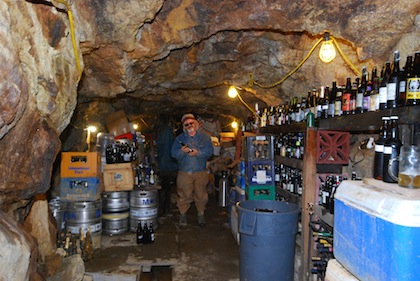Striking Gold
One of the most unique beer cellars ever constructed is in what was once a working goldmine. Danny Williams, who works with the Brewers Association, bought a parcel of land near Boulder, CO, to make his home. The property was also home to a former goldmine, located in a tunnel dug 3,000 feet into the side of a mountain. Williams strung lights down into the mine and turned it into a beer cellar for the nearly 4,000 bottles he’s collected over the years. The tunnel stays a cool 50 degrees all year long and there’s a small stream running through a portion of the mine, keeping the normally dry mountain air slightly humid.

The granddaddy of all beer cellars was once a working gold mine. Now filled with liquid gold, it is stocked and owned by the Brewer's Association's Danny Williams.
The Up or Down Debate
Experts disagree on whether beer with corks should be stored upright or lying on their side. Some insist that they should be laid on their side, like wine, to keep the cork moist, which will also help keep air from getting in the bottle.
But the majority agree that keeping your beer cellar just slightly humid will provide enough moisture so that the corks won’t dry out.
Upright proponents also point out the added benefit of keeping bottles standing tall also is good for the ullage—the air space between the liquid in the bottle and the cork—which should be kept as small as possible. This reduces the air acting on the beer and slows the oxidation process, which can give the beer a papery or cardboard taste and an overall stale quality. This will happen to every beer eventually, and in some beers it can take a positive form, adding sherry-like or leathery notes, but there’s really no reason to rush the process if you don’t have to.
Yet another advantage to storing beer upright is that the sediment stays in the bottom of the bottle, and out of your glass, when it’s finally time to pour the beer.
The Doctor Is In
William Sysak, know to his friends in the beer world as “Dr. Bill,” has been collecting and cellaring beer for many years. His medical title is honorary, from his years in the Army Medical Corps and later working in hospital emergency rooms. Two years ago he turned pro, and is currently the Beverage Coordinator of Stone Brewing World Bistro & Gardens near San Diego, CA.
But if anything, he’s not only maintained his home beer cellar, but expanded it. He’s turned almost the entire house into his cellar, using various nooks and crannies rather than one dedicated space. In that way, he explains “I have mini-habitats at different temperatures where I can run experiments and check aging variations” on how different conditions affect the same beer. He identified problem areas in his home and avoided using those spaces, but in some that were on the border—like his hot Southern California garage—he installed insulation to maintain an even temperature year-round. He also bought a large three-door cooler for the garage, but never turns it on since the ambient temperature stays cool enough on its own.
Sysak keeps a steady number in his cellar, somewhere around 2,000 bottles. Some of his most prized bottles waiting for that right moment to open include a 1977 Thomas Hardy Barley Wine, a 1999 Bellevue Selection Lambic Gueuze and forty year old Belgian beers from Affligem and Maredsous.











